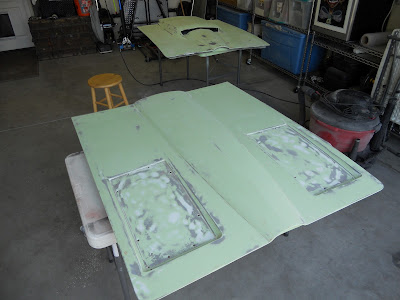The top of the hood has been primered 3 times, block sanded and guide coated in-between each coat. I let it dry for a full week then went over it with a red scuff pad to help the adhesion of the black primer sealer.
Two coats of black primer sealer were applied and allowed to dry for several days.
Then I flipped the thing over and continued to work on the underside.
Now here's the problem. I know it's the underside of the hood and I know nobody is going to pay it any attention. Yet I find myself giving it almost the same amount of attention as I did to the body of the car. Look at the sanding discs I am going through. Yes, I am block sanding the underside as well... but what the heck. I bought the car to keep me off the couch and it's doing that.
Here it is after it's first sanding. We still have a few spots of fiberglass showing so I'll add more primer.
Here it is, re-primered, re-sanded and ready for primer sealer.
The primer sealer really only needed to be applied around the perimeter of the underside of the hood since that's the only place that gets color. But I had a little extra primer left over so I sprayed the center section as well. The center will be painted with Por 15 Chassis Coat Black, the same stuff we used on the firewall and inner fenders.
Three medium coats of Lapis Blue were sprayed around the edges.
Then several coats of Cobalt Kandy Blue were sprayed followed by several coats of clear.
After drying for about 12 hours I started masking with 1/4" tape as shown. This was followed by 1" tape. This "two tape" method allows nice tight radiuses where the 1" alone can't do it.
Everything was then scuffed to remove all gloss. The area was cleaned with a wax and grease remover then all the holes and threaded areas were plugged with foam ear plugs. A final blast of air removed all lint and debris making the underside of the hood ready for paint.
3 medium coats of Por 15 were applied then allowed to dry for about an hour before the ear plugs and masking tape were removed. I'll let this dry for at least a day before I put it on the car. Hopefully it will fit as well as the 67 hood we were going to use originally. Wish us luck on that!

























































